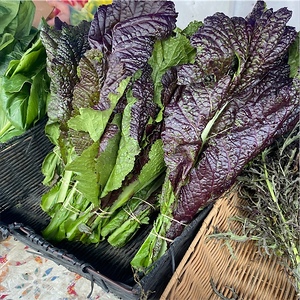


Red Mustard Greens
Estimated Inventory, 4 lbs : 0
Description/Taste
Red mustard greens have broad wrinkled leaves with a violet purple overlay and purple-green variegation. The leaves grow to 30 centimeters in length and up to 12 centimeters in width. Red mustard leaves are succulent and tender when young with a moderate peppery note and subtle nutty finish. As they mature, flavors sharpen and become more robust with notes of pepper, garlic and mustard.
Seasons/Availability
Mustard greens are a cool season crop, available winter through spring.
Current Facts
Red mustard greens are a variety of Brassica juncea, and collectively part a family of cruciferous vegetables including, turnips, broccoli and cabbage. Red mustard greens are grown for fresh eating, as a cover crop with pesticide qualities, for feedstock and as dual purpose ornamental greens in edible gardens. Osaka Purple mustard and Japanese Giant Red mustard are two commonly grown seed varieties.
Nutritional Value
Red mustard greens are rich in vitamins A, C and K. They contain compounds which have cancer preventing benefits, including antioxidants, anti-inflammatory and natural detoxifying properties.
Applications
Red mustard greens are interchangeable with most other varieties in the family, however their brilliant purple-red color give them extra visual appeal. They may be used in both cooked and raw preparations, depending upon their maturity. They are commonly implemented as a salad green, pot herb or braising green. Red mustard greens pair well with rich meats such as pork, lamb and sausages, creamy sauces, aged and melting cheeses, apples, peaches, cucumbers, citrus, vinegars, especially apple cider and rice, nuts like pistachios and hazelnuts, herbs and spices including cumin, cilantro, dill, garlic, fennel and coriander. The seeds of the mustard plant can be sprouted and eaten raw or dried and used as a spice or in pickling brine, and of course, to make the eponymous condiment.
Ethnic/Cultural Info
As an important part of Chinese and Indian cuisines, Mustard greens are usually harvested when fully mature offering a bold robust flavor. While western cuisines prefer the mildly sweet flavor of baby mustard greens.
Geography/History
Red mustard greens are Chinese in origin, but they eventually naturalized in Japan and quickly became a commonly grown vegetable. Taxonomists identify as many as seventeen subgroups of mustard greens that can differ sharply in heat, flavor, size and color. Differentiation in soil types and temperatures can affect the flavor and heat level of mustard greens. All Red mustard varieties prefer cool climates for growing with full sun and rich soil with temperatures below 68°F. Frost is tolerable, but freezing temperatures will kill crops.
Recipe Ideas
Recipes that include Red Mustard Greens. One
| Love and Duck Fat |
|
Sauteed Mustard Greens with Garlic and Sesame |
| Sara Moulton |
|
Southern Braised Mustard Greens with Ham |
| Saffron Trail |
|
Fried Rice with Mustard Greens |

















